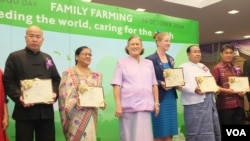Five farmers from the Asia-Pacific region received awards from a U.N. agency on World Food Day for their work and innovations in family agriculture.
“We all will need a doctor or a lawyer once in a while, but we will need a farmer three times a day,” said Estrella Penunia, secretary general of the Asian Farmers’ Association for Sustainable Rural Development at the ceremony.
The regional director of the U.N.’s Food and Agriculture Organization (FAO), Hiroyuki Konuma, noted the irony that while most of the food in the region is produced by smallholder family farmers “they constitute the largest portion of the poor and hungry in our society.”
Why are we poor?
“Why are we poor?” asked Penunia, who responded to her own question citing a variety of reasons, including: a lack of secure land rights, land grabs by private companies, unavailability of affordable good seeds, difficulty accessing capital, credit and loans, high input costs and bad roads hampering access to marketplaces.
Another challenge is convincing the next generation to stay on the farm and resist the temptation of higher-paying jobs in the cities.
“There must be sufficient investment in rural areas so that some of them will want to stay and take responsibility for feeding more and more people in a sustainable manner,” said Thailand’s Princess Maha Chakri Sirindhorn, who delivered the keynote speech at the event at FAO’s regional headquarters.
Why do they return?
One of the farmers honored at the Bangkok event, Jin Yuepin of Zhejiang province, China, is among those who have returned to his roots.
“In our village only old people and kids are left… Why did I come back to do farming? First of all, I want to preserve our traditional way to farm. I still remember my father’s smile each year at harvest time,” said Jin.
Jin, who began his working life as a dishwasher in a Paris restaurant, before eventually becoming a chef there, has returned to his hometown of Qingtian, where his success as a rice-fish farmer is being lauded by the FAO.
Speaking to VOA, Jin explained that he had an epiphany after returning from France in 2007 that ancient agricultural techniques could be superior to some modern ways.
“I saw fish raised in rice paddies. I immediately recalled the days when I was a kid and saw fish swimming so freely in the paddy field,” Jin remembers. “For several thousand years, we’ve been doing agriculture in such an ecologically clever way.”
Jin invested more than $250,000 for rice fish farming in his province, gaining both his rice and tripod fish national environmental certification as “green” foods.
Myanmar’s U Myo Thant began farming on a single hectare with one cow and one tractor. He now has two farms with more than 100 hectares each, employing about 50 workers.
He is able to harvest three bountiful crops per year, nearly quadrupling the yield of each one by using hybrid rice seeds.
“I’m the only farmer who is producing hybrid seeds in Myanmar,” he said.
He also grows beans and pulses, has eschewed chemical fertilizers and pesticides and plans to begin exporting his own rice.
The Mandalay Division farmer laments that the irrigation systems for agriculture in Myanmar, which is also known as Burma, are not as good as those in neighboring countries.
“If we have better irrigation systems, we can have more production,” he said.
The three others being honored from the region by the FAO are Shailaja Popatlal Navandar, who is teaching organic farming to other women in India’s Maharashtra state; New Zealand dairy farmer Ruth Yvette Hone; and Patphong Mongkolkarnchanakhoon of Kanchanaburi, Thailand, who uses biogas from pig waste to power his home and farm where he grows a variety of crops, including rice and mango and also raises, fish, chickens and ducks.
At least 60 percent more food is needed by 2050, according to the FAO, to feed an estimated nine billion people in the world - most of them in the Asia-Pacific region.






